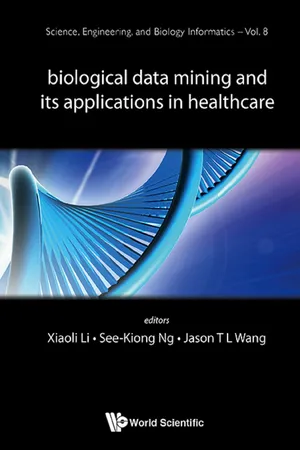
Biological Data Mining And Its Applications In Healthcare
- 436 pages
- English
- ePUB (mobile friendly)
- Available on iOS & Android
Biological Data Mining And Its Applications In Healthcare
About This Book
Biologists are stepping up their efforts in understanding the biological processes that underlie disease pathways in the clinical contexts. This has resulted in a flood of biological and clinical data from genomic and protein sequences, DNA microarrays, protein interactions, biomedical images, to disease pathways and electronic health records. To exploit these data for discovering new knowledge that can be translated into clinical applications, there are fundamental data analysis difficulties that have to be overcome. Practical issues such as handling noisy and incomplete data, processing compute-intensive tasks, and integrating various data sources, are new challenges faced by biologists in the post-genome era. This book will cover the fundamentals of state-of-the-art data mining techniques which have been designed to handle such challenging data analysis problems, and demonstrate with real applications how biologists and clinical scientists can employ data mining to enable them to make meaningful observations and discoveries from a wide array of heterogeneous data from molecular biology to pharmaceutical and clinical domains.
Contents:
- Sequence Analysis:
- Mining the Sequence Databases for Homology Detection: Application to Recognition of Functions of Trypanosoma brucei brucei Proteins and Drug Targets (G Ramakrishnan, V S Gowri, R Mudgal, N R Chandra and N Srinivasan)
- Identification of Genes and Their Regulatory Regions Based on Multiple Physical and Structural Properties of a DNA Sequence (Xi Yang, Nancy Yu Song and Hong Yan)
- Mining Genomic Sequence Data for Related Sequences Using Pairwise Statistical Significance (Yuhong Zhang and Yunbo Rao)
- Biological Network Mining:
- Indexing for Similarity Queries on Biological Networks (Günhan Gülsoy, Md Mahmudul Hasan, Yusuf Kavurucu and Tamer Kahveci)
- Theory and Method of Completion for a Boolean Regulatory Network Using Observed Data (Takeyuki Tamura and Tatsuya Akutsu)
- Mining Frequent Subgraph Patterns for Classifying Biological Data (Saeed Salem)
- On the Integration of Prior Knowledge in the Inference of Regulatory Networks (Catharina Olsen, Benjamin Haibe-Kains, John Quackenbush and Gianluca Bontempi)
- Classification, Trend Analysis and 3D Medical Images:
- Classification and Its Application to Drug-Target Prediction (Jian-Ping Mei, Chee-Keong Kwoh, Peng Yang and Xiao-Li Li)
- Characterization and Prediction of Human Protein-Protein Interactions (Yi Xiong, Dan Syzmanski and Daisuke Kihara)
- Trend Analysis (Wen-Chuan Xie, Miao He and Jake Yue Chen)
- Data Acquisition and Preprocessing on Three Dimensional Medical Images (Yuhua Jiao, Liang Chen and Jin Chen)
- Text Mining and Its Biomedical Applications:
- Text Mining in Biomedicine and Healthcare (Hong-Jie Dai, Chi-Yang Wu, Richard Tzong-Han Tsai and Wen-Lian Hsu)
- Learning to Rank Biomedical Documents with Only Positive and Unlabeled Examples: A Case Study (Mingzhu Zhu, Yi-Fang Brook Wu, Meghana Samir Vasavada and Jason T L Wang)
- Automated Mining of Disease-Specific Protein Interaction Networks Based on Biomedical Literature (Rajesh Chowdhary, Boris R Jankovic, Rachel V Stankowski, John A C Archer, Xiangliang Zhang, Xin Gao, Vladimir B Bajic)
Readership: Students, professionals, those who perform biological, medical and bioinformatics research.
Key Features:
- Each chapter of this book will include a section to introduce a specific class of data mining techniques, which will be written in a tutorial style so that even non-computational readers such as biologists and healthcare researchers can appreciate them
- The book will disseminate the impact research results and best practices of data mining approaches to the cross-disciplinary researchers and practitioners from both the data mining disciplines and the life sciences domains. The authors of the book will be well-known data mining experts, bioinformaticians and clinicians
- Each chapter will also provide a detailed description on how to apply the data mining techniques in real-world biological and clinical applications. Thus, readers of this book can easily appreciate the computational techniques and how they can be used to address their own research issues
Frequently asked questions
Information
Chapter 1
Mining the Sequence Databases for Homology Detection:
Application to Recognition of Functions of Trypanosoma brucei brucei
Proteins and Drug Targets
G. Ramakrishnan1, 2, V.S. Gowri2, ‡, R. Mudgal1, 2, N.R. Chandra3 and
N. Srinivasan2
1Indian Institute of Science Mathematics Initiative,
2Molecular Biophysics Unit,
3Department of Biochemistry, Indian Institute of Science,
Bangalore-560012, India.
‡Present Address: School of Life Sciences, Jawaharlal Nehru University,
New Delhi-110067, India
1. Introduction
2. Remote homology driven approaches for protein function annotation
2.1. Sequence-based approaches for remote homology detection
2.1.1. Iterated searches using PSI-BLAST
Table of contents
- Cover
- Halftitle
- Seriestitle
- Title Page
- Copyright Page
- Preface
- Contents
- Part I: Sequence Analysis
- Part II: Biological Network Mining
- Part III: Classification, Trend Analysis and 3D Medical Images
- Part IV: Text Mining and its Biomedical Applications
- Index